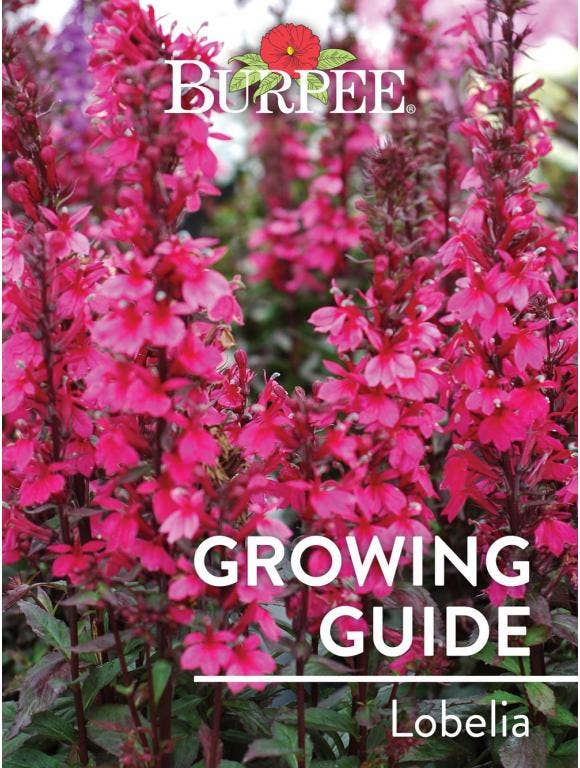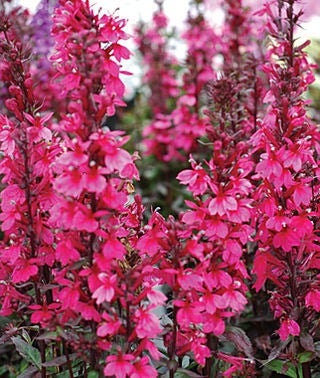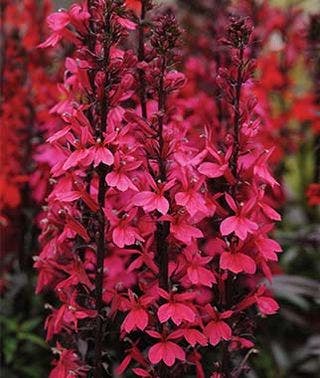
How to Sow and Plant Lobelia Perennials
Sowing Lobelia Seed Indoors:
- Sow indoors seeds 8-12 weeks before the last frost
- Sow thinly and just press into seed-starting formula
- Keep the soil moist at 65-75 degrees F
- Seedlings emerge in about 20 days
- As soon as seedlings emerge, provide plenty of light on a sunny windowsill or grow seedlings 3-4 inches beneath fluorescent plant lights turned on 16 hours per day, off for 8 hours at night. Raise the lights as the plants grow taller. Incandescent bulbs will not work for this process because they will get too hot. Most plants require a dark period to grow, do not leave lights on for 24 hours.
- Seedlings do not need much fertilizer, feed when they are 3-4 weeks old using a starter solution (half strength of a complete indoor houseplant food) according to manufacturer’s directions.
- If you are growing lobelia in small cells, you may need to transplant the seedlings to 3 or 4 inch pots when seedlings have at least 2 pairs of true leaves before transplanting to the garden so they have enough room to develop strong roots
- Before planting lobelia in the garden, seedling plants need to be “hardened off”. Accustom young plants to outdoor conditions by moving them to a sheltered place outside for a week. Be sure to protect them from wind and hot sun at first. If frost threatens at night, cover or bring containers indoors, then take them out again in the morning. This hardening off process toughens the plant’s cell structure and reduces transplant shock and scalding.
Planting Lobelia in the Garden:
- Select a location with well-drained, rich, moist soil in partial shade to full sun. If in full sun, make sure plants get plenty of water.
- Prepare the bed by turning the soil under to a depth of 6-12 inches removing any debris, and lightly raking as level as possible.
- The addition of organic matter (leaf mold, compost, well-rotted manure) benefits all gardens and is essential in recently constructed neighborhoods.
- Plant on a cloudy day or in late afternoon to reduce transplant shock.
- Dig a hole for each plant, approximately 6-8 inches apart large enough to amply accommodate the root ball.
- Unpot the plant and gently loosen the root ball with your hands to encourage good root growth.
- Place the top of the root ball even with the level of the surrounding soil. Fill with soil to the top of the root ball. Press soil down firmly with your hand.
- Thoroughly water and apply a light mulch layer on top of the soil (1-2 inches) to conserve water and reduce weeds.
How to Grow Lobelia Plants
- Keep weeds under control during the lobelia growing season. Weeds compete with plants for water, space and nutrients, so control them by either cultivating often or use a mulch to prevent their germination.
- Mulches can also be used to help retain soil moisture and maintain even soil temperatures. For perennials, an organic mulch of aged bark or shredded leaves lends a natural look to the bed and will improve the soil as it breaks down in time. Always keep mulches off a plant’s stems to prevent possible rot.
 Careful watering is essential in getting lobelia perennials off to a good start. Water thoroughly at least once a week to help new roots grow down deeply. Soil should be damp at about 1 inch below the soil surface. You can check this by sticking your finger in the soil. Water early in the morning to give all leaves enough time to dry. One inch of rain or watering per week is recommended for most perennial plants. You can check to see if you need to add water by using a rain gauge.
Careful watering is essential in getting lobelia perennials off to a good start. Water thoroughly at least once a week to help new roots grow down deeply. Soil should be damp at about 1 inch below the soil surface. You can check this by sticking your finger in the soil. Water early in the morning to give all leaves enough time to dry. One inch of rain or watering per week is recommended for most perennial plants. You can check to see if you need to add water by using a rain gauge.- Until the plants become established, some protection from extreme winds and direct, hot sunlight may be necessary. Good air movement is also important.
- After new growth appears, a light fertilizer may be applied. Keep granular fertilizers away from the plant crown and foliage to avoid burn injury. Use low rates of a slow release fertilizer, as higher rates may encourage root rots.
- Deadhead to encourage repeat blooming.
- Pinch plants if you prefer bushier growth.
- Do not cut back in fall, cut back in spring.
- Divide every 2-3 years.
Lobelia Varieties Available at Burpee Seeds
Lobelia Growing Tips
- Perennial lobelias are useful for difficult, wet locations. They are attractive in the middle or back of the border, and naturalize well in woodlands and along stream banks. They are very effective massed in the landscape.
- Lobelias make great cutting flowers as well. Cut when flowers are 1/3 open.
Perennial Growing Tips
Lobelia Common Disease Problems
Cercospora Leaf Blight: Small flecks which develop a yellowish halo appear on the leaves and turn brown and coalesce. They cause the leaves to wither and die. Burpee Recommends: Remove infected plants and destroy all plant debris.
Damping Off: This is one of the most common problems when starting plants from seed. The seedling emerges and appears healthy; then it suddenly wilts and dies for no obvious reason. Damping off is caused by a fungus that is active when there is abundant moisture and soils and air temperatures are above 68 degrees F. Typically, this indicates that the soil is too wet or contains high amounts of nitrogen fertilizer. Burpee Recommends: Keep seedlings moist but do not overwater; avoid over-fertilizing your seedlings; thin out seedlings to avoid overcrowding; make sure the plants are getting good air circulation; if you plant in containers, thoroughly wash them in soapy water and rinse in a ten per cent bleach solution after use.
Root Rots: A number of pathogens cause root rots of seedlings as well as mature roots. While perennial lobelia prefers wet soils, too wet soils over the winter can cause the roots to rot. Burpee Recommends: Pull up and discard infected plants.
Rust: A number of fungus diseases that cause rust colored spots on foliage and stalks. Burpee Recommends: Plant resistant varieties. Practice crop rotation. Remove infected plants. Contact your Cooperative Extension Service for recommendations.
Septoria Leaf Spot: This diseasecauses severe losses in the Atlantic and Central states. It is most severe during rainy seasons in closely planted gardens. It usually appears when the plants begin to set fruit. Circular spots with gray centers and dark margins appear on the lower older leaves. Fungi spores are produced and darken the center of the spots. There is a progressive loss of foliage and fruits suffer from sunscald. Burpee Recommends: Remove and destroy infected plant debris. Don't handle or brush against plants when they are wet. Rotate plantings. Remove weeds growing nearby.
Common Pest and Cultural Problems
Aphids: Greenish, red, black or peach colored sucking insects can spread disease as they feed on the undersides of leaves. They leave a sticky residue on foliage that attracts ants. Burpee Recommends: Introduce or attract natural predators into your garden such as lady beetles and wasps which feed on aphids. You can also wash them off with a strong spray, or use an insecticidal soap.
Japanese Beetles: Burpee Recommends: Hand pick early in the morning into a bucket of soapy water.
Slugs: These pests leave large holes in the foliage or eat leaves entirely. They leave a slime trail, feed at night and are mostly a problem in damp weather. Burpee Recommends: Hand pick, at night if possible. You can try attracting the slugs to traps either using cornmeal or beer. For a beer trap, dig a hole in the ground and place a large cup or bowl into the hole; use something that has steep sides so that the slugs can’t crawl back out when they’re finished. Fill the bowl about ¾ of the way full with beer, and let it sit overnight. In the morning, the bowl should be full of drowned slugs that can be dumped out for the birds to eat. For a cornmeal trap, put a tablespoon or two of cornmeal in a jar and put it on its side near the plants. Slugs are attracted to the scent but they cannot digest it and it will kill them. You can also try placing a barrier around your plants of diatomaceous earth or even coffee grounds. They cannot crawl over these.
Spider Mites: These tiny spider-like pests are about the size of a grain of pepper. They may be red, black, brown or yellow. They suck on the plant juices removing chlorophyll and injecting toxins which cause white dots on the foliage. There is often webbing visible on the plant. They cause the foliage to turn yellow and become dry and stippled. They multiply quickly and thrive in dry conditions. Burpee Recommends: Spider mites may be controlled with a forceful spray every other day. Try hot pepper wax or insecticidal soap. Check with your Cooperative Extension Service for miticide recommendations.
Lobelia FAQs
 Is cardinal flower a good plant for a pollinator garden? Yes, it is an excellent choice, attracting butterflies and hummingbirds, and beneficial insects as well.
Is cardinal flower a good plant for a pollinator garden? Yes, it is an excellent choice, attracting butterflies and hummingbirds, and beneficial insects as well.
Can I grow perennial lobelia in a container? Some varieties are large for containers, but some more compact ones are fine for containers. Do not allow to dry out.
Does perennial lobelia self sow? Lobelia tends to be a short loved perennial, but it often self sows.
Is lobelia deer resistant? Yes, lobelia is deer resistant.
Is perennial lobelia native? Yes, this is a native American plant that is well adapted as a garden plant.


